The world of web application development has undergone a massive transformation over the past decade. As we approach 2025, the landscape continues to evolve at a rapid pace, driven by advancements in technology, changing consumer expectations, and the growing need for businesses to remain competitive. The future of Web Application Development Services looks incredibly promising, and businesses must stay ahead of these trends to remain relevant and successful.
Web application development is an integral part of modern business, and as technology continues to advance, the demand for innovative web applications will increase. Web Application Development Services are the backbone of businesses’ digital strategies, helping them engage customers, streamline operations, and gain a competitive edge. As we move closer to 2025, several exciting developments are poised to shape the future of web application development, including AI, machine learning, cloud computing, and progressive web apps. This article delves into these technologies and trends, offering a glimpse into the future of web application development.
- 82% of web users access the internet through mobile devices.
- 50% of businesses plan to implement AI-driven features in their web applications by 2025.
- 72% of users expect a web application to load in less than 2 seconds.
- 85% of consumers are more likely to engage with Progressive Web Apps over traditional websites.
Current State of Web Application Development
Before we explore the future, it’s essential to understand where web application development stands today.
Technologies Driving Web Application Development
The current landscape of web application development is heavily influenced by the following technologies:
- JavaScript and frameworks like React, Angular, and Vue.js dominate the front-end development process.
- On the back end, Node.js, Python, Ruby on Rails, and PHP continue to be popular choices.
- APIs and microservices have become standard in creating scalable, flexible web applications.
- Cloud platforms such as AWS, Microsoft Azure, and Google Cloud provide the infrastructure for hosting, scaling, and securing web applications.
Key Trends in Web Application Development Today
- Mobile-First Approach: With mobile usage surpassing desktop, mobile-first development is now a standard practice.
- Single Page Applications (SPAs): SPAs, which allow for faster load times and smoother user experiences, have gained popularity.
- Security: Web application security remains a top priority, with the implementation of HTTPS, encryption, and security protocols becoming mandatory.
The Role of AI and Machine Learning in Web Application Development
AI and machine learning (ML) are no longer futuristic technologies; they are here and making an impact on web application development.
AI-Powered Web Applications
AI is revolutionizing web applications by enabling smart features such as:
- Chatbots and virtual assistants to provide 24/7 customer support.
- Predictive analytics for better decision-making.
- Natural language processing (NLP) for improved search functionality and personalization.
Machine Learning for Personalization
Machine learning algorithms analyze user data to deliver tailored content and experiences. As web applications become more personalized, the need for machine learning will grow. This allows businesses to offer:
- Personalized product recommendations.
- Dynamic pricing models.
- Targeted marketing strategies.
The Impact of Cloud Computing on Web Applications
Cloud computing is transforming web application development by enabling greater scalability, flexibility, and cost-efficiency.
Scalability and Flexibility
Web applications can be hosted on the cloud, which allows businesses to scale resources up or down based on demand. This results in:
- Cost savings as businesses only pay for the resources they use.
- Faster deployment and updates.
- Improved disaster recovery and redundancy.
Cloud-Native Web Applications
In the future, most web applications will be built natively for the cloud, enabling businesses to leverage cloud services more effectively and reduce reliance on on-premise infrastructure.
The Rise of Progressive Web Apps (PWAs)
Progressive Web Apps are web applications that offer an app-like experience on the web. These apps are set to dominate the future of web development due to their speed, reliability, and user engagement.
What Are PWAs?
PWAs combine the best features of web and mobile applications. They are fast, reliable, and responsive, providing a seamless experience across all devices.
Benefits of PWAs for Businesses and Users
- Offline capabilities: Users can interact with PWAs even when they are offline or have a poor internet connection.
- Push notifications: PWAs can send real-time notifications to users, improving engagement.
- Cost-effective: PWAs eliminate the need for separate mobile app development.
The Importance of Web Security in 2025
As web applications evolve, so do the security threats that accompany them. Ensuring the security of web applications will be a critical focus in 2025.
Emerging Threats to Web Applications
Web applications will continue to face threats such as:
- Cross-site scripting (XSS) attacks.
- SQL injection.
- Denial-of-service (DoS) attacks.
Best Practices for Web Security
To protect against these threats, businesses must adopt robust security practices, including:
- Regular security audits.
- Encryption for sensitive data.
- Multi-factor authentication for user logins.
The Evolution of Front-End Development
The front-end development process has seen significant advancements, and these will continue into 2025.
JavaScript Frameworks: The Powerhouses of Modern Web Apps
Frameworks such as React, Vue.js, and Angular are making it easier to develop complex, high-performance web applications. These frameworks allow for component-based development, enabling greater reusability, maintainability, and scalability.
The Role of Web Design in User Experience
As user experience (UX) becomes a central focus, web design will play a more critical role in ensuring the accessibility and engagement of users. Responsive design will be crucial for offering seamless experiences across devices.
Backend Development Trends
The backend development landscape is also evolving, with new methodologies and architectures being adopted.
Serverless Architecture
Serverless computing allows developers to build and run applications without managing servers. It offers:
- Reduced operational costs.
- Faster time to market.
- Automatic scaling based on traffic.
Microservices and Their Impact
Microservices architecture is becoming the go-to approach for large-scale web applications. By breaking applications into smaller, manageable services, businesses can improve:
- Scalability.
- Faultisolation.
- Independent service development.
Mobile-First Development
With mobile web traffic surpassing desktop traffic, the need for mobile-first development is more important than ever.
The Shift to Mobile-First
Mobile-first development ensures that websites and applications are designed with mobile users in mind, resulting in:
- Faster loading times.
- Better user engagement.
- Higher conversion rates.
Responsive Design and Its Importance
Responsive design ensures that web applications look and function well on any device, regardless of screen size. It provides:
- Consistent user experience across all devices.
- Improved SEO performance.
- Increased user retention.
The Role of Automation and DevOps in Web Development
Automation and DevOps practices will continue to streamline the development process, making web applications faster to develop and deploy.
Automating Web Development with CI/CD
Continuous Integration (CI) and Continuous Deployment (CD) automate the process of integrating new code changes and deploying them to production. This ensures:
- Faster release cycles.
- Reduced bugs and errors.
- Improved collaboration between teams.
The DevOps Culture in Web Application Development
DevOps fosters collaboration between development and operations teams, resulting in:
- Faster delivery of web applications.
- Improved collaboration and communication.
- Higher-quality products.
User-Centered Design and the Future of UX/UI
In 2025, user experience (UX) and user interface (UI) design will continue to be the driving forces behind successful web applications.
The Focus on User Experience
Web applications will need to provide exceptional user experiences to stay competitive. Key considerations include:
- Personalization: Customizing the user experience based on individual behavior.
- Usability: Ensuring web applications are easy to navigate.
- Accessibility: Designing for users with disabilities.
Designing for Accessibility
As the web becomes more inclusive, accessibility features such as screen readers and keyboard navigation will be crucial for creating applications that cater to all users.
How Web Application Development Services Will Evolve in 2025
In 2025, Web Application Development Services will offer more comprehensive solutions to meet the growing needs of businesses.
The Shift Towards Full-Cycle Development Services
Businesses will demand end-to-end solutions, from initial idea conception to maintenance and updates. Full-cycle development services will include:
- Consulting and planning.
- Development.
- Testing and deployment.
- Maintenance and updates.
The Growing Demand for Custom Web Applications
Off-the-shelf solutions will give way to more custom-built web applications designed to meet the specific needs of businesses. Custom web applications will offer:
- Unique features tailored to business goals.
- Scalability to accommodate growth.
- Security designed to protect sensitive data.
Conclusion
As we approach 2025, the future of web application development services promises exciting opportunities. Businesses will need to embrace emerging technologies such as AI, machine learning, cloud computing, and PWAs to stay competitive in an increasingly digital world. By adopting these innovations, businesses can deliver better user experiences, improve operational efficiency, and scale their operations more effectively. The key to success will lie in choosing the right Web Application Development Services that align with business goals and help achieve long-term success.
Frequently Asked Questions
1. What is the future of web application development in 2025?
In 2025, we expect a greater focus on AI, machine learning, cloud computing, and progressive web apps (PWAs). These technologies will significantly enhance user experience, scalability, and application performance.
2. How does cloud computing impact web application development?
Cloud computing offers businesses scalability, cost efficiency, and flexibility, making it easier to host and scale web applications as needed.
3. What are Progressive Web Apps (PWAs)?
PWAs are web applications that provide an app-like experience, offering benefits such as offline capabilities, push notifications, and improved performance.
4. Why is mobile-first development important?
With mobile usage surpassing desktop traffic, mobile-first development ensures that web applications are optimized for mobile devices, improving user engagement and satisfaction.







Leave a Reply